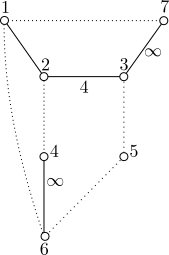Table of Contents
This page is divided into the following sections:
Encoding a Coxeter graph / encoding a Coxeter group
The Coxeter group acting on a n-dimensional space is specified by giving its Coxeter graph or Coxeter diagram with d vertices. In order to name its vertices, you have the following two possibilities:
- use integers between 1 and d
- use custom labels: the name of each vertex can contain letters, digits, - and _ (but no space)
The graph is written in a file as follows:
- First line [mandatory]: d, n
Where d is the number of vertices of the graph and n is the dimension.
Remark: The dimension is optional (see remark below). - Second line [optional]: name of the vertices
Remark: If this line is omitted, CoxIter will assume that the vertices are labelled with integers from 1 to d. If this line is specified, the format is the following: vertices labels: label1 label2 label3 ... - Following lines: vertex1 vertex2 weight
Remarks:- 0 is used to specifiy the weight infinity and 1 is used to specifiy a dotted edge
- Only one line per edge is sufficient
- The weight 2 doesn't have to be specified.
Remark about the dimension
If the dimension is not specified in the first line but is needed for the computations (for example for the compacity or finite volume tests), then CoxIter will determine the dimension by looking at the maximal spherical and euclidean graphs. In order to succeed, it is important that the associated polyhedron contains at least one vertex. Therefore, if you don't know this, try to specify the dimension.
Example
The group F4 can be encoded as follows:
It can also be encoded as follows:
Parameters of CoxIter
Mandatory parameters
- Parameters
-
-i Path to the file which encodes the Coxeter graph.
Example: -i graphs/graph.coxiter
Basic optional parameters
- Parameters
-
-full If specified, do almost all the possible computations (except the arithmeticity test): - Euler characteristic
- f-vector
- Finite volume test
- Compacity test
- Growth series
- Growth rate (if the PARI library is avaliable)
-arithmeticity If specified, the arithmeticity is tested.
Alias: -a
Remarks:- The group has to be non-cocompact.
- If the graph contains dotted lines, more tests might be needed (see Example 2).
-compactness If specified, CoxIter will test the cocompactness.
Aliases: -c, -compact, -compacity, -cocompact-debug If specified, the following information will be displayed - List of the connected euclidean graphs found
- List of the connected spherical graphs found
- List of the products of euclidean graphs (with their multiplicities)
- List of the products of spherical graphs (with their multiplicities)
Remarks:
- If -compactness is given and if the group is not cocompact, the graph which cannot be extended correctly
- If -fv is given and if the group is not of finite covolume, the graph which cannot be extended correctly
Since the output can be huge with this flag, it is suggested to also use -o and -of
-fv If specified, CoxIter will test whether the group is of finite covolume or not.
Alias: -fcv-g If specified, CoxIter will compute the growth series.
Aliases: -growth, -poincarre-growthrate If specified and if the PARI library is avaliable, CoxIter will compute the growth rate.
Advanced parameters
- Parameters
-
-drawgraph If specified, the Coxeter graph will be written
Alias: -dg
Require: -o
Remark: does not work on Windows.
Remark: see example below.-drop Label(s) of the vertex(vertices) to drop.
With this option, CoxIter will work on a subgraph of the encoded graph.
Example: use "-drop 3 -drop s2" to discard vertices 3 and s2 (and all edges starting from these vertices).-o Base name for the output
Example: "-o graphs/graph" will create files "graphs/graph.output" and "graphs/graph.jpg"-of If specified, the output of the program is written in a file (the parameter -o must be given)
Alias: -cf
Example: by specifying "-cf -o graphs/graph" the output is written in "graphs/graph.output"-oformat Format for mathematical output
Possible values are: generic, gap, latex, mathematica, pari
Example: "-pgm -oformat mathematica" will print the Gram matrix in the Mathematica format
Alias: -outputformat
Default: generic-pcg If specified, the Coxeter graph will be printed
For each vertex, a list of its neighbours is displayed-pgm If specified, the Gram matrix will be displayed
Remark: If the graph contains dotted edges, some variables will be added
See: -orformat-writegraph If specified, the graph will be written to be used in CoxIter
Alias: -wg
Require: -o
Example: by specifying "-wg -o graphs/graph" the output is written in "graphs/graph.coxiter"
Remark: You can combine this option with -drop and -drawgraph to draw a subgraph of an encoded graph.
Technical parameters
- Parameters
-
-nc If specified, some computations won't be done; they will be displayed to be given to a special software (Maxima, Mathematica, ...)
This parameter can be used in order to avoid the use of libraries BigInt and Rational_Numbers in CoxIter.-nopenmp If specified, OpenMP (parallel computations) is disabled
Alias: -nparallel
Use this if you call CoxIter from a parallelized program.
Examples
Example 1
We want to compute the invariants of the cocompact hyperbolic Coxeter group B8 in H8 found by Bugaenko.
We create in the folder "/CoxIter/graphs/" a file named "8-Bugaenko.coxiter" which contains the description of the graph (the 1 is for the dotted line):
We call CoxIter:
The output is the following
We copy the command
and we get the following image:

Example 2
We want to check if the following subgroup of Isom H3 is arithmetic:

We encode the graph as follows:
We call CoxIter with options to test arithmeticity and print the Gram matrix:
The output is then the following:
With the values l1m3=-Sqrt[5]/2, l2m4=-Sqrt[2], l0m5=-Sqrt[5], l4m5=-Sqrt[5], l0m6=-Sqrt[2], we see that the group is arithmetic.